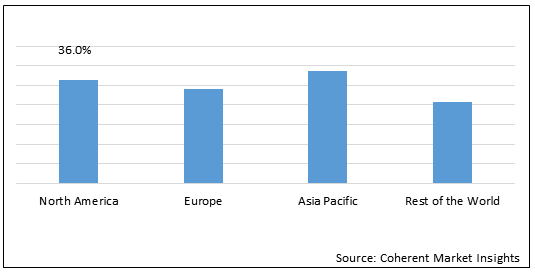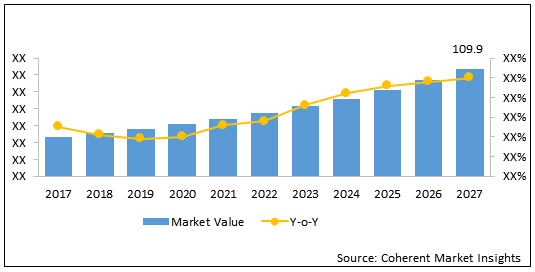Professional robots are a type of robot that is considered for use outside of a manufacturing facility within a professional setting. The majority of professional service robots are semi-autonomous or fully autonomous with some form of mobility. Generally, professional service robots work as an assistant to human beings by performing mundane, dangerous, or repetitive activities. Professional service robots offer to improve usability, accurate services, and reduced operational costs. These robots find applications in healthcare, construction, agriculture, military and defense, logistics, supply chain & warehouse, among others.
The global professional service robot market is estimated to account for US$ 109.9 Bn in terms of value by the end of 2027.
Market Dynamics- Drivers
Professional service robots are being used in a variety of sectors for numerous applications. For instance, in the healthcare sector, mobile medical robots are typically used to deliver medications and other sensitive materials in hospitals. Many robot manufacturing companies have introduced UVD robots that help hospitals to keep their premise sanitized with the help of ultraviolet light. For instance, in May 2020, Vanora Robots Pvt. Ltd., Indian robotics and artificial intelligence startup introduced an unmanned robotic platform to disinfect the rooms of hospitals, schools, etc. with UV light. Furthermore, professional service robots are used in the defense sector for transport, search & rescue, and attack. Thus, these diverse applications are expected to drive growth of the global professional service robots market during the forecast period.
The Internet-of-Robotic-Things (IoRT) is an emerging dynamic in the market that combines an autonomous robotic system with the Internet of Things (IoT) capabilities. It combines vision of connected sensors and smart objects prevalently embedded in the environment. IoRT can provide reduced troubleshooting, simplified wiring, automated adjustment, enhanced functioning, and less space occupation. With IoRT, business owners can monitor and analyze the performance of professional service robots. Supply chain businesses have been adopting IoRT effectively and are expected to gain traction in the near future. Therefore, these factors are expected to propel the global professional service robots market growth over the forecast period.
Statistics:
North America held dominant position in the global professional service robots market in 2019, accounting for 36.0% share in terms of value, followed by Asia-Pacific, Europe, and RoW respectively.
Professional Service Robots Market Report Coverage
| Report Coverage | Details | ||
|---|---|---|---|
| Base Year: | 2019 | Market Size in 2019: | US$ 12.2 Bn |
| Historical Data for: | 2016 to 2019 | Forecast Period: | 2020 to 2027 |
| Forecast Period 2020 to 2027 CAGR: | 24.5% | 2027 Value Projection: | US$ 109.9 Bn |
| Geographies covered: |
|
||
| Segments covered: |
|
||
| Companies covered: |
Northrop Grumman Corporation, Boston Dynamics, Inc., Daifuku Co., Ltd., Aethon Inc., AB Electrolux, Kuka AG, iRobot Corporation, Robert Bosch GMBH, Elbit Systems Ltd., Gecko Systems International Corporation, and Yujin Robot Co., Ltd. |
||
| Growth Drivers: |
|
||
| Restraints & Challenges: |
|
||
Uncover macros and micros vetted on 75+ parameters: Get instant access to report
Figure 1: Global Professional Service Robots Market Share (%), in terms of Value, By Region, 2019

To learn more about this report, Download Free Sample
Market Dynamics- Restraints
Initial capital investment for professional service robots is significantly high. Such massive investment is not affordable for small and medium-sized businesses and therefore they prefer to rely on manual labor. Besides, these robots require timely repair and maintenance operations, which incurs into additional cost. Hence, high capital investment and operational cost are expected to hamper the global professional service robots market growth over the forecast period.
One of the major issues with professional service robots is data privacy. Many robots can be hacked and can be used for illicit intentions. The robots used in the defense and military sectors are at most risk since those robots can be hacked used to spy, steal confidential data, and in worst case for attack. Although robot manufacturers are tightening security protocols, robots still remain susceptible to hacks. Thus, these factors are expected to drive growth of the global professional service robots market during the forecast period.
Market Opportunities
Apart from use in various end-use sectors, professional robots are now being used to provide assistance to people with disabilities. Disability robots are designed to help people who have physical disabilities that hinder their daily tasks. Disability robots have been proven to provide assistance to people who have abstained injuries that affect their daily chores. Furthermore, companion robots are another emerging concept where robots will be used for the geriatric population. These robots are highly intelligent and make useful assistants at home. They can remind elderly people to take their medications and other daily activities.
Artificial intelligence (AI)-enabled robots can be used in various sectors for numerous applications. AI gives robots a computer vision to sense, calculate, and navigate the reaction. AI-enabled robots can learn to perform their tasks from humans through machine learning and modify the tasks as per requirements. These robots are highly intelligent as compared to traditional robots and offer greater efficiency and productivity. AI robots also use sensors, actuators, and non-AI programming to improve their abilities. For instance, in June 2020, Qualcomm Technologies Inc. launched the Qualcomm Robotics RB5 platform, the company’s most advanced and comprehensive offering for robotics. RB5 platform delivers cutting edge technology for AI and machine learning.
Figure 2: Global Professional Service Robots Market Value (US$ Bn), 2017 - 2027

To learn more about this report, Download Free Sample
The global professional service robots market is expected to reach a value of US$ 109.9 Bn by 2027 at a CAGR of 24.5% between 2020 and 2027.
Market Trends
Key companies are focused on the development of new software solutions, in order to enhance the capabilities for professional service robots. For instance, in May 2020, RoboDK, a Canada-based robotic software company, partnered with RobCo SWAT, a Bulgarian robotics company, to provide robotic simulation software solutions to the automotive industry.
Robots-as-a-service (RaaS) is an emerging business model, which combines advanced technologies such as artificial intelligence, cloud computing, and shared services. The trend of the RaaS business model is rising in the market where robotics companies lease robotic devices as cloud-base services. RaaS offers affordable robotics service, provides customer satisfaction, and enhanced employee engagement.
Competitive Section
Major companies operating in the global professional service robots market are Northrop Grumman Corporation, Boston Dynamics, Inc., Daifuku Co., Ltd., Aethon Inc., AB Electrolux, Kuka AG, iRobot Corporation, Robert Bosch GMBH, Elbit Systems Ltd., Gecko Systems International Corporation, and Yujin Robot Co., Ltd.
Share
Share
Missing comfort of reading report in your local language? Find your preferred language :
Transform your Strategy with Exclusive Trending Reports :
Frequently Asked Questions
Select a License Type
Joining thousands of companies around the world committed to making the Excellent Business Solutions.
View All Our Clients